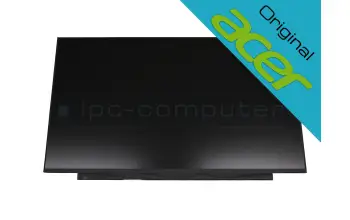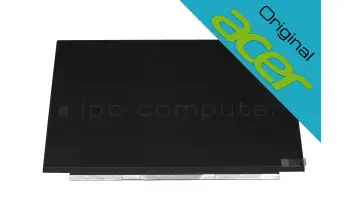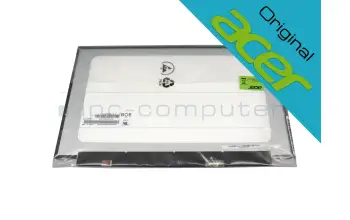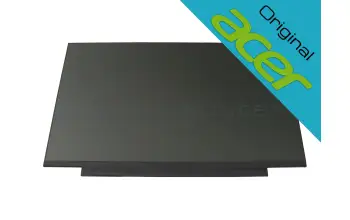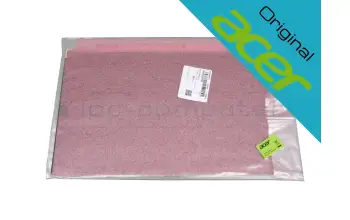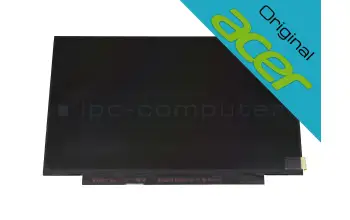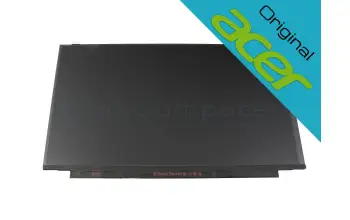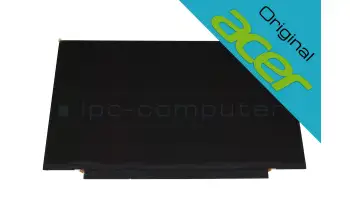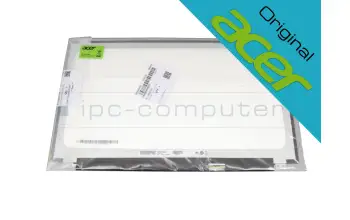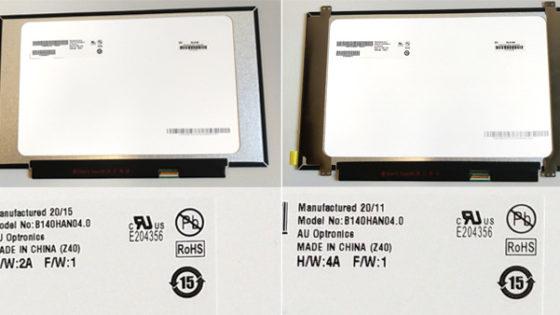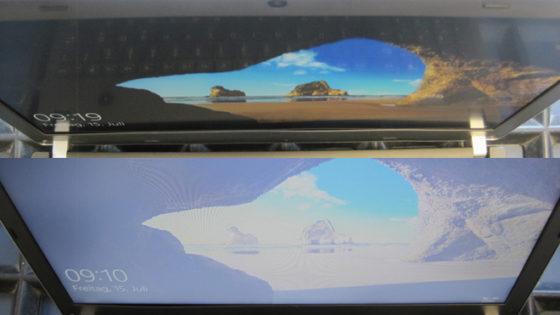Comprar pantallas Acer para Aspire y Predator al mejor precio
Todas las pantallas originales de Acer disponibles inmediatamente en stock

- Desde hace décadas somos el distribuidor oficial de repuestos para los portátiles Acer en Alemania.
- Sin compromisos - pantallas originales de Acer - la mejor calidad, ajuste óptimo, todo funciona - ¡garantizado!
- Si se pide antes de las 14:00 horas, se envía el mismo día laborable.
- Servicio de reparación y cambio: tarifas planas de reparación justas.
- ¿Quiere que un técnico profesional sustituya la pantalla defectuosa? Haga clic aquí para ir directamente al servicio de intercambio.

Encuentre la pantalla Acer adecuada por modelo o características
KL.1730D.012 Acer original IPS pantalla FHD mate 60Hz

más gastos de envío
Instalacion en nuestro taller de reparacion de portatiles
Reparación de la pantalla de tarifa planaKL.1730E.004 Acer original IPS pantalla FHD mate 60Hz

más gastos de envío
Instalacion en nuestro taller de reparacion de portatiles
Reparación de la pantalla de tarifa planaKL.14005.041 Acer original TN pantalla WXGA mate 60Hz

más gastos de envío
Instalacion en nuestro taller de reparacion de portatiles
Reparación de la pantalla de tarifa planaKL.1400E.008 Acer original TN pantalla WXGA mate 60Hz

más gastos de envío
Instalacion en nuestro taller de reparacion de portatiles
Reparación de la pantalla de tarifa planaKL.1400I.013 Acer original TN pantalla WXGA mate 60Hz

más gastos de envío
Instalacion en nuestro taller de reparacion de portatiles
Reparación de la pantalla de tarifa planaKL.14005.061 Acer original IPS pantalla FHD mate 60Hz

más gastos de envío
Instalacion en nuestro taller de reparacion de portatiles
Reparación de la pantalla de tarifa planaKL.14005.050 Acer original Toque IPS pantalla FHD mate 60Hz

más gastos de envío
Instalacion en nuestro taller de reparacion de portatiles
Reparación de la pantalla de tarifa planaWie finde ich das passende Display zu meinem Laptop?
Die einfachste und zielführendste Möglichkeit, das passende Display zu finden, ist über die Hersteller/ Modell Navigation. Mit dem blauen Kasten links oben wählen Sie zunächst Ihr richtiges Laptop-Modell aus. Daraufhin werden Ihnen alle dazu kompatiblen Displays angezeigt.
Verschiedene Bildschirm-Auflösungen
Damit das Display zu Ihrem Laptop kompatibel ist, muss auch die Auflösung stimmen. Hier kann es unterschiedliche Ausführungen bei dem gleichen Laptop-Modell geben. Die passende Auflösung für Ihr neues Display finden Sie im Windows bei Einstellungen unter Bildschirmauflösung.
Einige Auflösungen haben wir hier für Sie aufgelistet
| Fach-Bezeichnung | Auflösung |
|---|---|
| HD (High Definition) | 1366 x 768 Pixel |
| HD+ (High Definition Plus) | 1600 x 900 Pixel |
| Full HD (Full High Definition) | 1920 x 1080 Pixel |
| QHD+ (Quad High Definition Plus) | 3200 x 1800 Pixel |
| WQHD (Wide Quad High Definition) | 2560 x 1440 Pixel |
| UHD (Ultra High Definition) | 3840 x 2160 Pixel |
Glänzend oder matt?
Bei einem matten Display ist die Oberfläche angeraut, so werden Spiegelungen im Display stark reduziert. Dies kann vor allem in hellen Räumen oder im Freien von Nutzen sein.
Glänzende Displays haben eine glatte Oberfläche, was das Bild schärfer erscheinen lässt. Ebenso sind Farben und Kontrast besser. Solch eine Oberfläche wird häufig eingesetzt bei professionellen Monitoren für Film-und Fotobearbeitung.
In den meisten Fällen bieten wir die Displays sowohl mit matter als auch glänzender Oberfläche an. Sie können also selbst entscheiden, welche dieser beiden Varianten Sie bevorzugen.
Display-Reparatur selbst durchführen?
Um Ihr defektes Display daheim selbst auszutauschen, sollten Sie auf jeden Fall über ein ausreichend technisches Know-how verfügen. Zudem wäre eine speziell für Ihr Laptop entworfene Ausbau-Anleitung von Nutzen.
Im Allgemeinen empfehlen wir Ihnen aber, den Display-Tausch von unserem erfahrenen Notebook-Techniker durchführen zu lassen. Dies ist nicht viel teurer als ein einfacher Display-Kauf. Außerdem können Sie vollkommen sicher sein, dass Ihr Display danach wieder einwandfrei funktioniert. Um einen Einblick zu bekommen, wie so ein Display-Tausch aussehen kann, haben wir auf unserem YouTube-Kanal einige Reparaturen für Sie abgefilmt.
Conocimientos útiles sobre el tema de las pantallas Acer
Acer Display und Bildschirm FAQ
Hier finden Sie alle wichtigen Fragen und Antworten rund ums Thema Notebook Displays
- Can I swap my notebook display myself
With a bit of technical knowledge and a manual specific to your notebook this could be possible.
We recommend letting a specialist do it.
Here a video as an example:
- My Display is flickering, do I need a new one
- In most cases a flickering of the display indicates its defect, then it will have to be swapped.
- In some cases it can be the display cable, then the display will not have to be exchanged.
- My Display has lines
Vertical or horizontal lines are almost always a sign for a display damage.
A display damage is also indicated by lines that (dis-)appear when the display is pressed on.
In this case the display has to be exchanged.
- Why is my Display extremely dark
If the Display is black, but the Desktop can still be seen a bit, this means, that the background light has died.
Some of the errors could be:
- A defective inverter or CCFL tube
- A broken cable
- The switch detecting whether the lid is open or closed could be stuck
- There could be a damage on the Mainboard.
In most cases it is probably best if you send your device in for repair to a specialist.
- What is the difference between EDP and LVDS
Both are methods of connecting internal displays in devices like laptops or all-in-one PCs. LVDS stands for Low Volatage Differntail signaling and only specifies, that signals are transmitted using a lower voltage than usual. This allows higher data rates due to lower crosstalk and interference. When talking about the connection of a display via LVDS, the protocol FPD-Link (Flat Panel Display Link) is usually meant, which uses LVDS. This protocol has been introduced in 1996 and has been the main way of connecting internal displays for a long time. However, with the steady increase in the resolution of displays, FPD is reaching its limits.
That is why in 2008 Embedded DisplayPort (EDP) has been introduced. It is based on the external connection DisplayPort and is constantly being refreshed. It has no problem connecting displays with a 4K resolution at over 60Hz refresh rate, whereas LVDS is over at FHD (1080p).
- What is the difference between matte and glossy displays
The difference is in the surface of the display. A matt display has a slightly ruff surface. This greatly reduces reflections, which is very beneficial for working in rooms with bright lights or outdoors. Additionally, fingerprints and dust are not so visible.
However glossy displays also have their advantages. Due to the extremely smooth surface the picture is a bit sharper and colors and contrast are also better, provided the display beneath the coating is good enough. Professional movie and photo editing monitors often use a glossy display in combination with a large anti-glare shield for the optimal image.
- What is the difference between IPS and TN
TN, short form of Twisted Newmatic, panels have been the standard for flat-panel displays for a long time. Now they are being replaced by IPS (In-Plane-Switching) panels. The biggest disadvantage of TN panels is, that they only display a relatively small number of colours and that they have bad viewing angles. That means that if you don’t look at the panel in a 90° angel the colours quickly appear dull and distorted.
IPS displays solve these problems, they even show correct colours when looking at them almost at a 180° angle. However they still have some disadvantages compared to TN panels. They generally have a higher response time which means they take longer to display an image on screen. This is why gamers sometimes still prefer TN panels.
- What are the differences between digitizer, display units and displays
The digitizer is a part of the display; however, it does not display any images. Its main function is to protect the LCD underneath and it also handles touch input, if touch is present.
The LCD unit underneath the digitizer consists of the backlight and the LCD, which handles the colors of each pixel.
The display unit is all of this together. So, it contains the digitizer, LCD, backlight and usually a frame around all of it.
- Which display resolutions are there
Nowadays, there are dozens of slightly different display resolutions for laptops and monitors. In order to stay on top of things, we created an overview of the most important ones.
UHD 3840x2160 WXGA+ 1440x900 QHD+ 3200x1800 WXGA+ 1400x1050 WQHD 2560x1440 SXGA+ 1366x768 WUXGA 1920x1200 HD 1280x1024 FHD 1920x1080 SXGA 1280x800 WSXGA+ 1680x1050 WXGA 1024x768 UXGA 1600x1200 XGA 1024x600 HD+ 1600x900 - What displays are compatible with my Notebook
Only displays that are specifically made for your notebook are compatible.
- There are displays with different kinds of backlights. Either CCFL or LED lights are used only the type that is already in use will fit.
- Size and resolution also have to be identical.
- How can I measure the size of my notebook display
You have to measure the diagonal of your display by measuring from one corner to the opposite one.
You might have to convert from cm to inches. 1 inch is 2,54 cm, so a 19" display would also be a 48cm display.
- Wie öffne ich mein Laptop fachgerecht – und worauf muss ich beim Displaytausch achten?
Das Öffnen eines Laptops erfordert Sorgfalt, das richtige Werkzeug und etwas Erfahrung.
Grundregeln beim Öffnen:
- Gerät vollständig vom Strom trennen und, falls möglich, Akku entfernen bzw. stromlos schalten.
- Geeignetes Feinmechanik‑Werkzeug und ESD‑Schutz verwenden.
- Gehäuseschrauben systematisch lösen und Bodenabdeckung vorsichtig mit einem Kunststoff‑Tool abheben.
- Keine Gewalt anwenden – viele Geräte besitzen versteckte Schrauben unter Gummifüßen oder Aufklebern.
In unserer Reihe „Mein Laptop von innen“ zeigen wir anschaulich, wie verschiedene Notebook‑Modelle aufgebaut sind und welche Schritte nötig sind, um sie sicher zu öffnen.
Die Videos helfen dir, die Bauweise unterschiedlicher Marken (z. B. HP, Lenovo, Dell, Acer) besser zu verstehen und zeigen, wo sich Akku, Mainboard oder RAM befinden.
Wenn du dir beim Öffnen unsicher bist oder fest verbaute Komponenten besitzt, übernehmen unsere Techniker in der Werkstatt den sicheren Ausbau und die Reparatur. - Where can I find the part number of my display
The part number can be found on the back of your Display, however finding it requires disassembly of your notebook.
See also:
- How can I find the correct Display for my Notebook
- You can measure the diagonal of your display by measuring from one corner to the opposite one.
- If you need to you can then convert it from cm to inches or vice versa (1 inch = 2,54 cm) to get the desired measurement.
- Some sticker on the device can also contain further information about the Display.
- If you can not find any information you will have to remove the display to see its part number on the back.
- How can I recognize a pixel error in my Display
When manufacturing a Display there can be errors in some pixels. This will result in the pixel or sub-pixel not letting any light pass or never blocking light. If a complete pixel is defective it will either be black or white. However, the same error can also occur in a subpixel, which will then result in it always/never displaying its respective color (either red, green or blue). Due to the very high number of pixels such errors are almost impossible to avoid, and that is why displays with a few pixel errors are still shipped.

